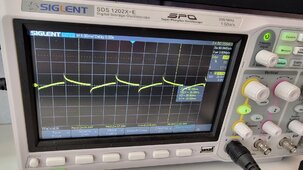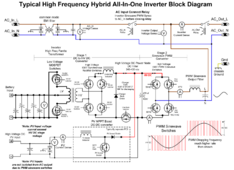I have noticed some pretty large interferance coming from the panels themselves. Now I know that panels radiating switching noise based on their converter isn't uncommon and there are ferrite chokes to deal with that if it becomes a problem.
For me though I'm getting interferance radiating at 50Hz (or 100hz)

I'm using an easun 3.2kw hybrid. The pure sine output has a little HF noise on it but honestly not too bad.
I first noticed the effect with microphones picking up a mains buzz. I thought maybe there was some ground loop issue so made sure the ground was correct all tied to the common point.
So normally if you place your finger on the scope input you'll couple some 50z into it from ring mains etc. But I am seeing pretty large square wave peaks.
It took me a while to pinpoint this but I can now see that its the solar array itself. In my office the roof has 6 panels and they are connected in series which means there's effectively a loop. So at 8A which they are running at thats an air cored electromagnet pointed at my head, but its DC.
I'm not sure how the actual inverter is designed or coupled to the PV input but it looks like the entire array is acting like one plate of a giant capacitor whose polarity switches when the AC mains is crossing zero or maybe at peak. I don't think ferrites are going to cure this.
To prove that its the array I can switch the main isolator, no difference, I can go into grid bypass mode, no difference and then finally switch the panel isolator and then it goes away completely.
I don't think its faulty I think its to do with the way the PV is switched into the DC bus in the inverter.
Has anyone else seen this? I'm guessing it just doesn't bother anyone else and people just assume the inverter is noisy which oddly it isn't its pretty well behaved.
For me though I'm getting interferance radiating at 50Hz (or 100hz)

I'm using an easun 3.2kw hybrid. The pure sine output has a little HF noise on it but honestly not too bad.
I first noticed the effect with microphones picking up a mains buzz. I thought maybe there was some ground loop issue so made sure the ground was correct all tied to the common point.
So normally if you place your finger on the scope input you'll couple some 50z into it from ring mains etc. But I am seeing pretty large square wave peaks.
It took me a while to pinpoint this but I can now see that its the solar array itself. In my office the roof has 6 panels and they are connected in series which means there's effectively a loop. So at 8A which they are running at thats an air cored electromagnet pointed at my head, but its DC.
I'm not sure how the actual inverter is designed or coupled to the PV input but it looks like the entire array is acting like one plate of a giant capacitor whose polarity switches when the AC mains is crossing zero or maybe at peak. I don't think ferrites are going to cure this.
To prove that its the array I can switch the main isolator, no difference, I can go into grid bypass mode, no difference and then finally switch the panel isolator and then it goes away completely.
I don't think its faulty I think its to do with the way the PV is switched into the DC bus in the inverter.
Has anyone else seen this? I'm guessing it just doesn't bother anyone else and people just assume the inverter is noisy which oddly it isn't its pretty well behaved.




